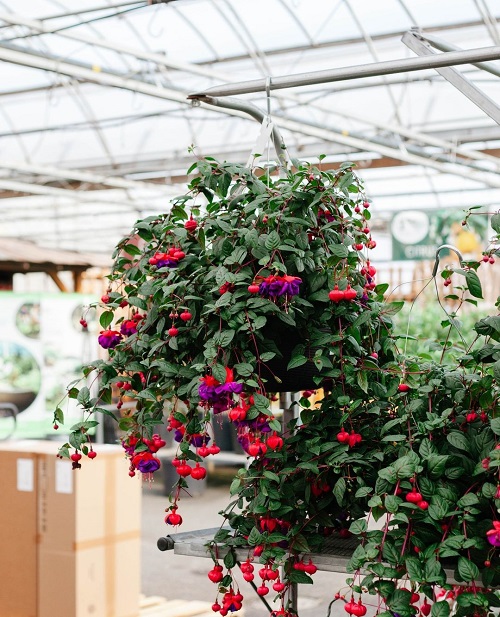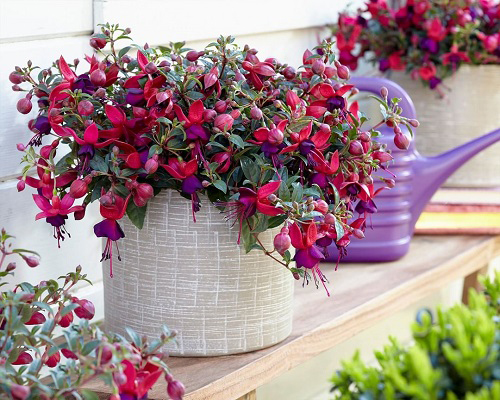Growing Fuchsia Indoors can be a rewarding experience, thanks to its vivid clusters of flowers that look fantastic in hanging baskets!

How about having a blooming delight in the midst of Pothos and Rubber Plants? If this sounds interesting, you must grow Fuchsia Indoors!
These 16 Fuchsia Variety Colors will Make You Plant Them Instantly
Fuchsia Plant Profile
These plants are native to Central and South America – however, their few species are native to New Zealand and Tahiti, too. Fuchsia is quite adaptable and thrives from mountainous regions to forested areas.
What makes these plants stand out are the flowers – they come in shades of pink, purple, red, and white. The blooms also have a distinctive shape – appearing like a teardrop with drooping petals!
Fuchsias generally bloom from late spring to early fall – however, the peak blossoming season is usually in the summer months, particularly from June to August. This can change depending on the varieties and climatic conditions, too.
Best Varieties of Fuchsia to Grow Indoors

- Fuchsia ‘Tom West’: It is loved for the red and purple flowers with ruffled petals. This variety’s compact growth makes it perfect for small hanging baskets.
- Fuchsia ‘Hawkshead’: If you want a bushier version, you will love this. Its pure white blossoms offer a stark contrast to the typical Fuchsia colors.
- Fuchsia ‘Pink Marshmallow’: As the name suggests, ‘Pink Marshmallow’ Fuchsia has soft pink, double flowers.
- Fuchsia ‘Hoop-skirted’: The ‘Hoop-skirted’ displays a lovely combination of deep pink and purple hues.
- Fuchsia ‘Pink Galore’: The prolific blooming nature of this variety ensures continuous blossoms indoors.
16 Best Fuchsia Varieties for Hanging Baskets and Pots
Propagating Fuchsia Indoors

Fuchsias are really easy to propagate using cuttings – so much so that even a newbie can do it!
The best time to take the cutting and planting is late winter or early spring. This ensures that the new plant will benefit from the lengthening days (Warmth) and milder temperatures.
Begin by choosing a healthy plant (With plenty of blooms, of course!). Now, pick a healthy stem and take a 4-6 inches long segment of it (Below the node) using clean shears.
To prevent any chances of infection and disease, it will be a good idea to dip the end of the stem in a rooting hormone – your cutting is now ready to start its journey to become a plant!
Take a pot and fill it with a well-draining potting mix – you can also go for a mixture of peat and perlite, or vermiculite.
Plant the cutting at about 1/2-1 inch deep in the soil. Moisten the growing medium slightly and cover the cutting using a plastic bag to create a humid environment.
Place the pot where it gets plenty of bright and indirect light throughout the day. Do make sure to open the plastic cover every 2-3 days to let some fresh air in. Moisten the soil whenever it feels a little dry to the touch.
If all goes well, the cutting will form roots in 2-3 weeks, and you can see new growth in 3-4 weeks.
Requirements for Growing Fuchsia Indoors

Location
Fuchsias grow best when they get bright and indirect light all day long – it will ensure that the plant thrives, grows more leaves, and also stays safe from the dangers of scorching, which can happen if the foliage gets exposed to the harsh afternoon sun for a long time – especially in the warmer zones, .
These plants flower from June to August (This window maybe more or less, depending on the weather and varieties) – so it would be a good idea to start exposing the plant to the direct mild morning sun for 3-4 hours when you see the buds appearing – this will help in it developing better flowers!
Soil
Fuchsias need a well-draining, rich, moisture-retentive, and slightly acidic to neutral soil with a pH of 6.0-7.0. Follow this recipe that covers all the bases.
- 2 parts high-quality potting mix
- 1 part compost – for organic matter and nutrients
- 1 part perlite or vermiculite – for drainage and aeration
- A handful of fine bark or coir chips – for drainage and moisture retention (Optional)
Mix all these well, and watch your fuchsias thrive!
Water
Keep the soil consistently moist, as a dry medium can kill the plant – however, this doesn’t mean that you should water the plant daily – NO!
Follow the simple rule of moistening the growing medium only when the top-inch goes a little dry.
Remember – Wilting leaves/drooping flowers are a sign of underwatering.
Temperature
For best growth, keep the temperature between 55-85 F (12-27 C). Avoid exposing the plant to temperatures below 10 C (50F) – keeping it away from AC vents and cold windows is a must!
Fuchsia Plant Care

Fertilizer
It would be a great idea to feed the plant using a balanced liquid fertilizer, after diluting it to 1/2 of its strength, once in 4-6 weeks. This will supplement the growth and formation of more stems – remember, more stems equals more area for flowers to grow!
Before the flowering period (1-2 month/s before), apply a thin layer of well-rotted manure at the base of the plant – make sure the leaves are not touching it.
Mix 2 banana peels in the growing medium, 1 month before the flowering period – they are high in potassium, a vital nutrient for flowering. They also release nutrients slowly – meaning they’ll supplement the plant for a longer period of time.
Note: Do not use everything together.
Humidity
These plants thrive in a humid environment, so it would be a good idea to keep the pot on a pebble tray filled with water. If you are growing them in a hanging basket – get a humidifier and place it near the plant.
Important: Low humidity can cause the buds to dry out and drop before they bloom. So, it’ll be good to get a humidifier, especially before the blooming season!
Pests and Diseases
Fuchsias can fall victim to many pesky critters like aphids, whiteflies, and mealybugs. Fungus gnats might also buzz around these if the soil is moist. All you need is a spray of water or neem oil to get rid of these.
If you keep the soil damp for a long time, your Fuchsia might get leaf spot disease or botrytis. So, avoid overwatering and ensure there’s good air circulation wherever you keep it.
Overwintering Fuchsias
These plants are not cold tolerant, but you don’t have to discard them before the colder months.
To keep them alive, move to a cooler, dimly lit spot (a garage or covered patio is ideal) before the first frost. Also, reduce watering to once every 3-4 weeks.
Now, in March, give it a little pruning – take away the yellowing or dead parts of the leaves and stems. Water the plant thoroughly till it starts to seep out from the drainage hole at the bottom.
Once done, keep it near an east-facing window. Fertilize using a balanced liquid fertilizer, diluted to 1/4 of its strength, once in 3 weeks. This will support its growth and help it prepare for the new cycle.
This step is crucial if you live in a colder climate to induce dormancy in the plant.


